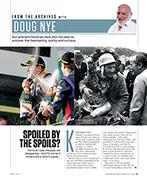
Spoiled by the spoils
Formula 1 pay cheques are staggering – but it’s not as if drivers are in short supply… Kimi Räikkönen famously encountered stormy waters late last year, when his ‘Lotus’ team’s…
A LOW-POWERED TWO-SEATER The Boulton LE. Paul ” Phamix”
wHEN the Boulton and Paul “Phoenix,” made its first appearance at the Aero Exhibition last year, it aroused a considerable amount of interest, not only because it was the lowest-powered English t w o
shown, b u t because it also represented a revival of the simpler type of light plane..
Since the Show little has been .seen publicly of the ” Phoenix,” but it has, nevertheless, been in active use during the greater part of the past twelve months, mainly for experimental purposes. Of wooden construction, it was at first fitted with an A.B.C. horizontallyopposed ” Scor pion ” engine, and one of its most interesting features is the construction of the elevators and rudder, which are of the same shape and form, so that complete interchangeability is
type, covered with plywood, and
possible. More recently, it has been modified in various ways, and now has a 40 h.p. nine-cylinder Salmson power unit installed. The fuselage is of the box-girder
from the cockpit it tapers considerably towards the tail, terminating with a horizontal tailpost to which are attached the elevators. There is no fixed tailplane, nor is there any fin, and the rudder, which is partially balanced, is mounted some distance in front of the elevators. The main plane has a fairly high aspect ratio, and is without dihedral; it is attached above the fuselage on steel tubular struts at the centre section and faired lift struts run from the lower longerons to the front spars. The wings and all controlling surfaces are fabric covered. The undercarriageTworks on
the Oleo system ; the shock-absorbing units are fixed to two long struts which terminate at the wing, and two radius struts pivot on the bottom longerons. A very wide track is provided and there is no axle. Fuel and oil tanks are situated in front of the front cockpit, and the petrol feed is by gravity. In its present guise, the ” Phoenix,” shows a very good all round performance—a quick take-off, a comfortable landing speed, and a top speed of about 90 m.p.h. It is also possible to carry out aerobatics on the machine,
and a quite remarkable demonstration of inverted flying was carried out at the B. & P. aerodrome at Mousehold, Norwich, with it some little time ago.
Owing to the fact that the manufacturers are fully occupied at the present time with the construction of machines for the R.A.F., they have not made arrangements, so far, for putting their little ” Phoenix ” into production, but it is possible that developments may take place in this direction in the future.